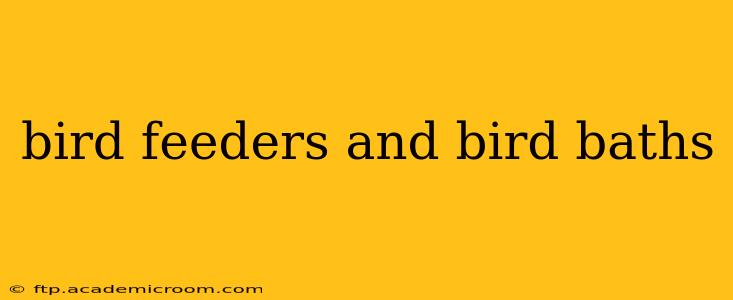Want to transform your backyard into a vibrant avian sanctuary? Bird feeders and bird baths are essential tools for attracting a diverse array of feathered friends, bringing beauty and lively activity to your outdoor space. This comprehensive guide explores the benefits, selection, placement, and maintenance of both, helping you create the perfect haven for birds.
Why Attract Birds to Your Garden?
Beyond the sheer joy of observing birds, attracting them to your garden offers numerous benefits. Birds are natural pest controllers, consuming insects and weed seeds, reducing the need for harmful pesticides and herbicides. Their cheerful songs add a soundtrack to your day, enhancing your overall outdoor experience. Furthermore, providing food and water sources contributes to local bird populations, helping to support biodiversity.
Choosing the Right Bird Feeder
The type of bird feeder you choose significantly impacts the types of birds you attract. Different feeders cater to different feeding styles and preferences.
Types of Bird Feeders:
- Tube Feeders: These are popular choices, dispensing seeds through multiple feeding ports. They are generally easy to clean and refill.
- Hopper Feeders: These larger feeders offer a significant amount of seed storage, ideal for larger flocks or areas with frequent bird activity.
- Platform Feeders: These are open, flat feeders suitable for a variety of birds, including those that prefer to feed on the ground. They're also great for offering suet or fruit.
- Suet Feeders: These feeders hold high-energy suet cakes, a rich source of fat crucial for birds during colder months.
- Tray Feeders: Similar to platform feeders but often with a cover to protect the food from rain or snow.
What to Feed Birds:
The type of birdseed you choose influences which birds visit your feeder. Black oil sunflower seeds are a popular all-around favorite, attracting a wide variety of species. Nyjer seeds attract finches, while shelled peanuts appeal to jays and woodpeckers. Always check for quality and freshness to avoid spoiled food.
The Importance of a Bird Bath
A bird bath provides essential hydration, particularly crucial during hot summer months and periods of drought. Birds rely on clean water sources for drinking and bathing, helping them maintain their plumage and hygiene.
Choosing the Right Bird Bath:
Consider these factors when selecting a bird bath:
- Size: A larger bath allows multiple birds to use it simultaneously.
- Depth: The bath should have shallow areas for smaller birds to safely access water.
- Material: Durable, weather-resistant materials such as stone or ceramic are ideal.
- Placement: Position the bath in an open area, away from dense vegetation where predators might hide.
Placement and Maintenance of Feeders and Baths
Proper placement and regular cleaning are crucial for the health and safety of your feathered visitors.
Optimal Placement:
- Feeders: Place feeders at least 4-5 feet from trees and shrubs to deter predators. Consider multiple feeders strategically placed to accommodate different bird species and feeding preferences.
- Bird Baths: Position bird baths in a sunny location, away from overhanging branches where predators could perch. Add rocks or pebbles to provide safe perches.
Cleaning and Maintenance:
- Feeders: Regularly clean feeders to prevent the spread of disease. Remove old, spoiled seed and wash thoroughly with a solution of mild soap and water.
- Bird Baths: Change the water daily to prevent the growth of bacteria and algae. Scrub the bath regularly with a brush and soapy water.
What Type of Bird Feeders Should I Use?
The best type of bird feeder depends on your budget and the specific birds you want to attract. Budget-friendly options include tube and hopper feeders, while platform feeders are suitable for ground-feeding birds. Suet feeders offer high-energy food for birds needing extra sustenance.
How Often Should I Clean My Bird Feeder and Bird Bath?
Bird feeders should be cleaned at least once a week, or more often during hot, humid weather. Bird baths require a daily water change, and a thorough cleaning at least once a week with soap and water.
What Kind of Bird Bath Is Best?
The best bird bath is one that is durable, easy to clean, and provides shallow water for small birds. Consider materials like stone or ceramic for their durability and weather resistance.
Where Should I Place My Bird Feeder and Bird Bath?
Place feeders at least four feet away from trees or shrubs to prevent predators from ambushing birds. Bird baths should be placed in an open, sunny area away from dense vegetation to provide a safe and accessible water source.
By following these tips and creating a welcoming environment, you can successfully attract a wide variety of birds to your backyard, enjoying the beauty and benefits of their presence for years to come. Remember, a little effort goes a long way in fostering a thriving avian community in your own backyard.
